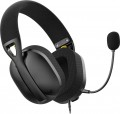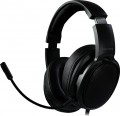Detachable cable
Headphones in which the cable is mounted on a detachable mount and can be detached. A standard 3.5 mm mini-Jack usually acts as a mount, sometimes a USB connector, and the wire itself may not even be included in the package.
This feature is popular primarily among combined models, see "Type of connection": when working in wireless mode, the cable can be disconnected so that it does not hang out in vain. But for purely wired headphones, the main convenience is that, if desired, the “native” wire can be replaced with another one that differs in length, type (see above), connection connector, etc. If desired, you can even keep several
detachable cables with different characteristics and change them as needed. In addition, if the detachable wire is damaged, you do not need to buy new headphones or go to the workshop — just buy a new cable.
Among the disadvantages of this option, one can note the risk of losing the wire, as well as a slightly increased likelihood of distortion due to the presence of additional connectors.
Impedance
Impedance refers to the headphone's nominal resistance to AC current, such as an audio signal.
Other things being equal, a higher impedance reduces distortion, but requires a more powerful amplifier — otherwise the headphones simply will not be able to produce sufficient volume. Thus, the choice of resistance depends primarily on which signal source you plan to connect the "ears". So, for a portable gadget (smartphone, pocket player), an indicator of
16 ohms or less is considered optimal,
17 – 32 ohms is not bad. Higher values —
33 – 64 ohms and
65 – 96 ohms — will require quite powerful amplifiers, like those used in computers and televisions. And models with a resistance of
96 – 250 ohms and
above are designed mainly for Hi-End audio equipment and professional use; for such cases, detailed recommendations for selection can be found in special sources.
Power
Headphone power is expressed in milliwatts (mW) - this figure can vary from a modest figure of 1 mW to an impressive level of 5000 mW. For the vast majority of headphones, power is not a decisive factor. In essence, this is an indicator of how loud the sound can be without the risk of damaging the drivers. At the same time, the parameter is important for some professional studio and audiophile models - in this case, power means the maximum audio signal level that is allowed to be supplied to the headphones from the sound source. If the headphones are used with a device that supplies too strong a signal, they may distort the sound or fail.
Frequency range
The range of sound frequencies that headphones can reproduce.
The
wider this range, the more fully the headphones reproduce the spectrum of sound frequencies, the lower the likelihood that too low or too high frequencies will be inaccessible. However, there are some nuances to consider here. First of all, let us remind you that the perceptual range of the human ear is on average from 16 Hz to 22 kHz, and for the complete picture it is enough for headphones to cover this range. However, modern models can significantly exceed these boundaries: in many devices the lower threshold
does not exceed 15 Hz, or even
10 Hz, and the upper limit can reach
25 kHz,
30 kHz and even
more. Such wide ranges in themselves do not provide practical advantages, but they usually indicate a high class of headphones, and are sometimes given only for advertising purposes.
The second important point is that a wide frequency range in itself is not a guarantee of good sound: sound quality also depends on a number of parameters, primarily the amplitude-frequency response of the headphones.
Sensitivity
Rated headphone sensitivity. Technically, this is the volume at which they sound when a certain standard signal from the amplifier is connected to them. Thus, sensitivity is one of the parameters that determine the overall volume of the headphones: the higher it is, the louder the sound will be with the same input signal level and other things being equal. However, we must not forget that the volume level also depends on the resistance (impedance, see above); moreover, it is worth choosing “ears” for a specific device first by impedance, and only then by sensitivity. In this case, one parameter can be compensated for by another: for example, a model with high resistance and high sensitivity can work even on a relatively weak amplifier.
As for specific figures, headphones with indicators of 100 dB or less are designed mainly for use in a quiet environment (in some similar models, the sensitivity
does not exceed 90 dB). For use on the street, in transport and other similar conditions, it is desirable to have more sensitive headphones — about
101 – 105 dB, or even
110 dB. And in some models, this figure can reach
116 – 120 dB. and even
more.
It is also worth noting that this parameter is relevant only for a wired connection according to the analogue standard — for example, via a 3.5 mm mini-
...jack. When using digital interfaces like USB and wireless channels like Bluetooth, the sound is processed in the built-in headphone converter, and if you plan to mainly use this kind of application, you can not pay much attention to sensitivity.Frequency range
The range of audio frequencies that the headphone's own microphone can normally "hear".
Theoretically, the wider this range, the more advanced and high-quality the microphone is, the closer the sound transmitted by it is to the real one. In fact, extensive frequency coverage is not always required. So, the working range of the human ear is about 16 – 22,000 Hz, and even then not everyone hears its upper part. And human speech usually covers frequencies from 500 Hz to 2 kHz, at least this range is considered quite sufficient for its transmission. So if you need a microphone for simple tasks like voice communication on the Internet or game chat, you can not pay much attention to the frequency range: even in the most modest models, it is more than sufficient for normal speech transmission.
Sensitivity
The sensitivity of the headphone's own microphone.
The more sensitive the microphone, the higher the signal level from it, at the same sound volume, and the better this model is suitable for picking up quiet sounds. Conversely, low sensitivity filters out background noise. At the same time, we note that these nuances are important mainly in professional work with sound. And for simple tasks like voice communication over the phone or via the Internet, sensitivity does not really matter: in headphones of this specialization, it is selected in such a way as to ensure that the microphone is guaranteed to work.
Ear cushion material
For full-size headphones, ear pads are often made of
genuine leather,
leatherette,
textile, velor, leatherette, memory foam, as well as their combined variations. In the caste of in-ear headphones, completely different materials are used - the most common are silicone pads, which gently adapt to the individual structure of the auricle, and as an alternative to them, foam ear pads with a porous structure (so-called “sponges”) are offered. Here are some features of commonly used ear pad materials:
- Textiles. Fabric ear pads are usually found in budget headphone models, but sometimes they are also used in the premium segment. The tactile textile ear pads are pleasant to the touch, and they also allow air to pass through well. In terms of acoustic properties, these are completely neutral materials. Note that such ear pads can be made from various types of fabrics (for example, microfiber).
- Leatherette. Artificial leather substitutes are used in headphones of all price categories. In fact, the properties of this material depend on the specific type of leatherette: ear pads made of conventional eco-leather can have excellent “breathing” qualities, while low-grade leatherette often provokes increased sweating of the ears (especially in the hot season).
- Genuine Leather. Genuine leather is a premium product used in corresponding flagship-level
...headphone models. Thick leather provides proper sound insulation and deep bass response. At the same time, your ears may sweat when using leather ear pads. To avoid increased sweating, the leather is often made perforated.
— Velor. The most delicate material to the touch with excellent sound-absorbing abilities. Velor ear pads provide good noise insulation, and headphones with them do not cause fatigue even after a long stay on the head. However, the material also has disadvantages: it gets dirty easily, attracts dust and pet hair, and wears out quickly.
- Alcantara. Ear pads made of artificial suede, which are as close as possible in properties and tactile sensations to velor products. However, Alcantara is easier to clean from dirt and lasts much longer. Alcantara ear pads are found in top-level headphones.
- Foam rubber. Foam ear pads are the prerogative of budget over-ear headphones. The fact is that this is a short-lived material that often requires replacement due to its low strength. Partially, special impregnations solve the problem, but foam rubber still retains its structure for a relatively short time.
- Fur. Quite a rare type of material for making ear pads. Headphones with characteristic fur ear pads perform a practical function - they warm the listener’s ears during the cold season.Weight
The total weight of the headphones; for true wireless models (see "Cable Type"), the weight of each individual earbud is listed.
This parameter is directly related to the design (see above) and some features of the functionality. Thus, the mentioned true wireless devices are very light, their weight
does not exceed 25 g. More traditional in-ears and in-ears can be noticeably heavier,
up to 50g for in-ears and up
to 100g for most in-ears. Overhead models, for the most part, are quite massive: among them there are many models weighing
200 – 250 g,
250 – 300 g and even
more than 300 g. It should be noted that a significant weight for false ears is often not a disadvantage, but an advantage: it allows them to stay on the head more securely, creates an impression of solidity and reliability, and most often does not create significant inconvenience.

